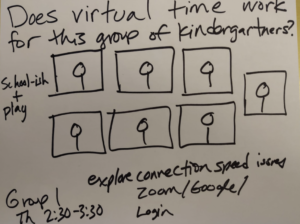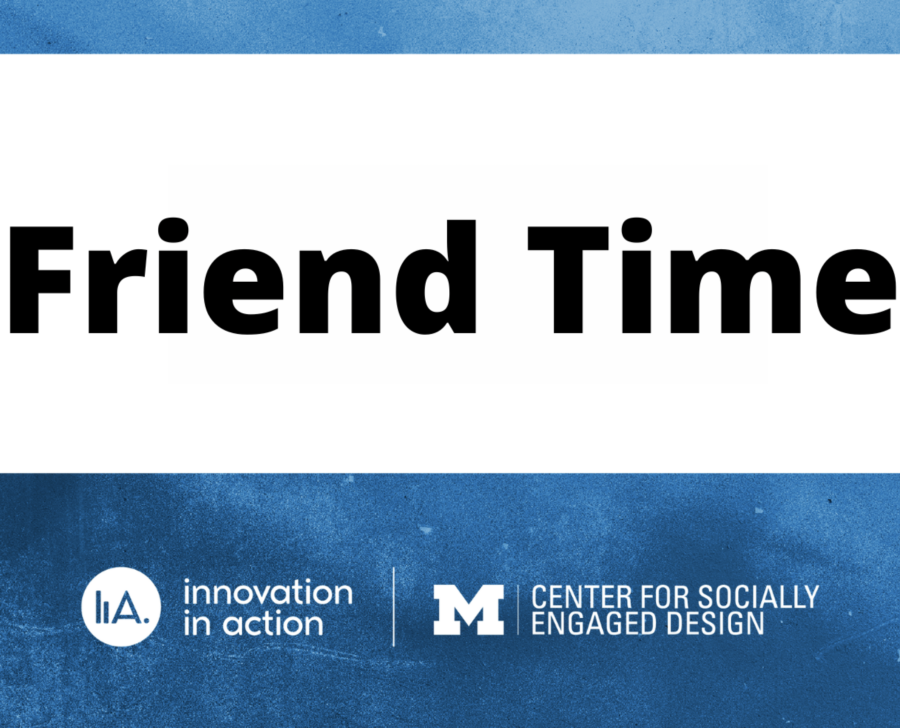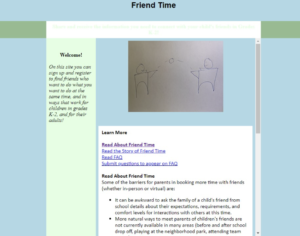Friend Time: A Parent Organized Social Platform
Story by Sydney Moore
The Origins of the Project
Friend Time, created by Patrice Johnson and Taryn Cyrus, helps parents of children in grades K-2 coordinate social time with friends. It started as a platform for parents to interact and form a community for their kids during COVID, which we believe is different from comparative options because it is parent organized and centered around existing friendships. This is significant because parents can often feel uncomfortable with the idea of unknown adults interacting with their kids, especially during COVID. Safety and trust are paramount and difficult for businesses to provide. Having a tool like Friend Time, where parents are always informed and involved, is exactly what parents are looking for.
Taryn first reached out to Patrice with the idea for Friend Time after moving to a new neighborhood during a COVID lockdown. She started off just wanting to find some friends for her daughter, age six at the time, but she wasn’t sure where to look. The question became can k-2 kids adjust to learning and interacting with their friends solely online?

A whiteboard ideation session for the first prototype
Since we’d known each other for a while, and had already figured out how to work flexibly together, it was easy to set up a trial and error way of operating and experimenting. Plus, the target audience was Taryn and people like her, which made things easier in some ways. The first prototype involved reviewing school material for about an hour a day with six kindergarteners. The kids could stay on the zoom call after to play with each other, giving parents additional time. Since its creation, Friend Time has evolved into a space that Taryn compared to ‘virtually knocking on the door to see if they can come out and play.’
During Friend Time’s early stages, Patrice hadn’t enrolled as a student at the University of Michigan yet, so she wasn’t familiar with user experience (UX). In retrospect, we wish we would have taken the time to sketch out experiences. There’s lots of technical things to consider and we probably would have progressed quicker if we’d taken more time at the beginning. For example, the parents in the original prototype group had a relaxed approach to monitoring their kids because they knew Taryn, which meant that she spent portions of sessions actively monitoring and responding to texts. Before we decided to create an app we were simply texting all of the parents involved. It would have saved us a lot of time if we had thought of a way to ping parents so that they were more aware of what their kids were doing, or set up a way for them to communicate, for example, whether they wanted to be notified of things like potential sound or connection speed issues. Over time we have also learned that the people that you are building for want to be involved, and they are usually open to looking at drafts and providing detailed, helpful feedback.
What will Friend Time look like after COVID
The unintended benefit of our early prototypes was that the kids were ready for online school by the time fall arrived in 2020. Since then, everything has been changing so frequently that there were several points where we had to step back and evaluate whether Friend Time would still be useful even if we didn’t finish by a certain point in time. This reflective process helped us realize that Friend Time would still be valuable as kids went back to school. Even now, parent interaction with schools is limited, so Friend Time can serve as an additional way of engaging children with their friends and school community. At this point students have adjusted to online school, but COVID brought to light the need for parents still working from home and people’s differing comfort levels.
Through Innovation in Action (IiA), we learned how to keep the project current. If you’d like to watch our final IiA presentation, please check it out on youtube. Our ideas of storytelling and prototyping are what changed the most. In particular, Patrice realized there were a lot of things she’d done previously that related to storytelling in the broad sense (such as the involvement of communities in storytelling). Patrice appreciates how IiA exposed her to ideas outside of the School of Information, particularly different approaches to prototyping.
Additionally, we got a lot of feedback about potential expansions of our audience. IiA reviewers suggested that Friend Time could be adapted to allow adults who like the product to interact with each other, or for kids who have limited mobility. Moreover, as this project developed we’ve realized that kids don’t have to age out of it. Even though Friend Time was originally designed for younger kids, because many could not use tools designed for general audiences without experiencing frustration, the same kids can continue to use it as they grow older. We weren’t expecting our idea to be so transferable among populations, but it’s been fun to see this project evolve.
Future Directions
Going forward, we want to do more prototyping! We’ve learned from every prototype we have tried and we know there’s still so much more to figure out. As Patrice first heard in Michael Nebeling’s Intro to Prototyping class, “everything is a prototype,” and now we realize how true this is as there’s no real end to design.
We also want to start experimenting with different types of projects. We’ve learned that activities which are already based in visuals transfer well, but distribution of physical materials can be a challenge. Furthermore, we are looking to add someone to the team with experience developing apps. To follow along on our journey, check out our website, and if you have any questions feel free to email us at educator@umich.edu.



